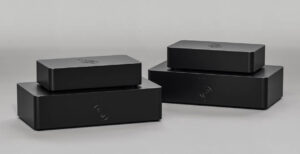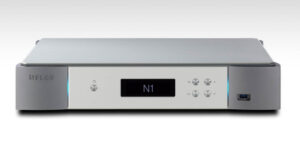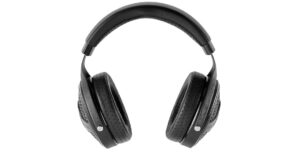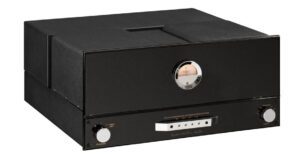
Britain and Europe certainly lead the way in terms of Network Music players: Linn, Naim and recently Cyrus, Revox and Electrocompaniet have been extolling the virtues of UPnP (Universal Plug n Play) players for some time, and many European audiophiles have recognised this as the ideal way to extract music from computers and networks. Our pals across ‘the pond’ still seem to favour the Mac’n’DAC approach – in which you store your music on a laptop, and use music player software to squirt your tunes into the USB input of a separate converter. The release of the Krell Connect suggests that high-end audiophiles in the USA have finally seen the light and are beginning to appreciate UPnP server as a music storage device working with a dedicated renderer to which the music is transported through Ethernet and an IP network: this methodology is so superior to storing music on a general purpose laptop and then squeezing it down a USB cable through a processor-hungry piece of player software into a hi-jacked DAC. All I can say at this juncture is Bravo, Krell! The 24-bit/192kHz-capable Connect is the first such streamer to be released by the American company and the plan is that its release will be followed within one month by a DAC-equipped variant.
Although it has made some excellent CD players and was the first brand to take the iPod seriously as an audiophile source with its curiously-named Papa Doc, Krell is still best known for its amplifiers: these are recognised and respected for their outstanding linearity, their ability to drive virtually any loudspeaker to any SPL while maintaining the same consistent sound quality, detail, dynamics and openness. Krell’s history of source components suggest similar attributes from other electronics that the company might produce, including as this network player. It certainly has a similar ‘macho’ build quality to the current range of amplifiers, with its substantial aluminium fascia. The fascia, which has a three-dimensional sculptural element in the middle that conceals a dual colour lighting device that emits a red glow when the unit is in Standby mode, then glows blue when the Connect is fully operational. The fascia also hosts an elegant but simple 3.5-inch QVGA LCD colour screen, in which the control menu appears. One can command the Connect with the supplied substantial aluminium remote handset and there is an app that is freely available for Apple iOS in the Apple Store, to ‘drive’ the Connect. Apart from a power on/off control that is the fascia described: there are only the connections on the rear panel breaking the Connect’s feature-free appearance. Along with the expected IEC mains receptacle and switch, RJ-45 Ethernet connection, and a USB input, there are co-axial and optical digital outputs alongside single-ended and balanced audio outputs. There is also a wi-fi aerial, but from experience of streaming devices, wired is the belt-and-braces, more robust approach.
The Connect features no internal storage and merely renders files that are stored elsewhere on the network to which it is connected. It also provides access to internet radio including use of the vTuner service, where, having registered your Connect, you can access the likes of hi-res stations along with ‘regular’ broadcasts and store them as ‘Favourites’.

Krell suggests using Twonky as the control software for your UPnP/DLNA server. I have a copy of this on one of my back-up music servers but rarely use it because I find its navigation cumbersome. On my primary server I use Illustrate’s Asset (version 4), whose operation I find flawless and wholly reliable. This worked perfectly with the Krell/iPad combination providing swift access to my music library.
I installed the Connect on top of one of my Quadraspire Sunoko Vent stands, wired it with an MCRU #85 mains lead and hooked it into my Gigabit network switch with Meicord Opal Ethernet cable. I then connected its output to my Naim DAC with a Chord Company Sarum Tuned ARAY digital interconnect. The DAC fed my Naim Reference system and pair of NAP250 power amplifiers driving Neat Ultimatum XL10 loudspeakers in bi-amp configuration through Chord Signature speaker cables.
I was eager to audition the Connect having read the company’s assertion that, with its easy-to-use interface, it represents “the pinnacle of network streaming audio gear.” Krell is certainly right about the interface, which I find slicker than the Naim iOS apps, even though I am extremely familiar with these and use them every day.
I am happy to report that listening to the Krell and a Naim side by side and switching their outputs through my reference system neither was truly better than the other. And this coming from someone with so much Salisbury-fi, I dream in black and green. That’s a fairly big feather in the cap for Krell right there; it’s in what could be classed as ‘enemy territory’ here and it doesn’t retreat and it doesn’t surrender. Of course there were differences between them, but ultimately, they all came down to a series of ‘how do you take your coffee?’ type differences of personal preference, and not the ‘this one is great, but this one blows’ kind.
The presentation of the Krell Connect compared to my Naim HDX is subtle but distinct. The Krell’s precise detail and especially its abilities at producing inherently correct tone and soundstage was clear throughout. This can be a double-edged sword with some music, such as a selection of Lou Reed and Velvet Underground tracks (and in particular the live recordings from the Bottom Line and Max’s Kansas City in New York). The Krell is adept at conveying the nature of these recordings, especially the excruciatingly poor quality of the mono, boombox, cassette tape from Max’s. The lack of fi – of any description – here is painfully obvious in both systems, but the Krell’s detail retreival affords the recording no forgiveness. With the Naim you can almost ignore the recording, whereas through the Krell one always has to listen to the music through the recording.
Listening to recordings not recorded through the medium of ‘biscuit tin’, such as Madeleine Peyroux’ “Standing On The Rooftop” and Cassandra Wilson’s “Belly Of The Sun”, the Krell brings out the pristine clarity of the recordings and highlights the precise nature and dimensionality of the soundstages. It clearly relishes the subtle dynamic contrasts and vocal detailing on the Wilson rip and delights in the rich instrumental tonality and vocal delicacy of the Peyroux tracks. Both rips sound wonderfully vivid and scrupulously candid – in the best possible way – through the Connect.
Listening to tracks from the Tedeschi Trucks Band album Revelator it was clear that the eleven-piece band had only three members who were not of Afro-caribbean descent, the streamer confidently relayed the rhythm that is fundamental to this band’s music-making. The Krell conveys the bass guitar and two drummers’ contributions to tracks such as “Bound For Glory” and forges a groove with alacrity and reproduces their funky swagger well.

The Krell Connect gives a wholly impressive performance here detailing Derek Trucks’ slide guitar on this and other tracks – you know, for example, that he is not using a steel slide from his tone and the sustain he achieves with his gloriously rich sounding modified 1961 Gibson SG Standard with PAF pick-ups that contrasts with his wife’s uncharacteristically fat-sounding Fender Telecaster. It is a wonderful combination and sounds magnificent in harmony with the accompanying keyboards. The Krell appears to extract tone like it is going out of fashion and it conveys the horn stabs with vigour and controlled enthusiasm – just the way the band plays them live.
The Krell also does a magnificent job of separating and then scrupulously detailing the voices behind Susan Tedeschi’s powerful lead in songs such as “Midnight In Harlem”. Their relative lack of volume – in the choruses, for example – does not affect the scrutiny with which the Krell inspects them and reveals how they are performing.
All things considered, in fact, it seems that Krell has a genuine and worthwhile winner on its hands with the Connect, its first network music player. A confident recommendation… and hopefully a welcome introduction to UPnP streaming for a continent.
Technical Specifications
Inputs: Wi-Fi, Ethernet and USB
Outputs: Toslink optical and coax digital, balanced XLR and single ended RCA analogue
Supported Formats: FLAC, Ogg, WAV, WMA, Apple Lossless, MP-4a, MP3. Up to 192kHz/24-bit playback
3.5-inch QVGA (320×240) LCD Display
Internet Radio UPnP/DLNA-compliant
iOS and Android apps for control. IR Remote optional.
vTuner equipped
Dimensions (HxWxD): 8.8×42.8 x43.3cm
Weight: 8.16kg
Price: £2,500 (As tested, £3,500 with built-in DAC)
Manufactured by:
Krell Industries
URL: www.krellonline.com
Distributed by:
Absolute Sounds
URL: www.absolutesounds.com
Tel: +44 (0) 208 971 3909
Back to reviews https://hifiplus.com/reviews
Tags: FEATURED
By Malcolm Steward
More articles from this authorRead Next From Review
See all
Reiki Audio SuperSwitch Master Pro + Servant Pro
- Mar 27, 2024

Melco Audio N1-S38 music server
- Mar 27, 2024

Focal Utopia 2022 headphones
- Mar 27, 2024











